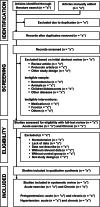Effect of isometric exercise on blood pressure in prehypertensive and hypertensive individuals: protocol for a systematic review and meta-analysis of randomized controlled trials
- PMID: 35596197
- PMCID: PMC9123753
- DOI: 10.1186/s13643-022-01974-9
Effect of isometric exercise on blood pressure in prehypertensive and hypertensive individuals: protocol for a systematic review and meta-analysis of randomized controlled trials
Abstract
Background: Systemic arterial hypertension (HTN) is the leading risk factor of cardiovascular disease death. Lifestyle changes are key for the prevention and management of HTN. Regular aerobic exercise training is recommended as part of the management of HTN, and dynamic resistance exercise should be prescribed as an adjuvant to aerobic training. Recent evidence points to the potential benefits of isometric resistance training in reducing blood pressure (BP). Yet, the hypotensive effect of isometric exercise in prehypertensive and hypertensive individuals is not fully understood. Thus, we will examine the effect of isometric exercise in prehypertensive and hypertensive individuals through a systematic review and meta-analysis.
Methods: Our systematic review study will include randomized controlled trials (RCTs) selected from the electronic databases MEDLINE (PubMed), Cochrane, LILACS, EMBASE, Web of Science, and PEDro published in English, Spanish, and Portuguese languages. We will follow the PRISMA-P (Preferred Reporting Items for Systematic Review and Meta-Analysis Protocols) and PICOS framework. Our search will involve studies with both male and female participants aged 18 years or more diagnosed with prehypertension or HTN performing one session of isometric exercise (acute effect) or isometric exercise training (chronic effect) compared to a control group (no exercise). We will use the Cochrane Risk of Bias 2 (RoB 2) tool to evaluate the quality of the studies and RStudio software (v1.3.959 for Windows) for statistical analyses.
Discussion: A meta-analysis of a homogeneous sample of prehypertensive and hypertensive individuals involving isometric handgrip exercise alone can further support previous findings and improve our understanding and recommendations for the management of these populations.
Systematic review registration: PROSPERO CRD42020213081.
Keywords: Blood pressure; Hypertension; Isometric exercise; Prehypertension.
© 2022. The Author(s).
Conflict of interest statement
The authors declare that they have no competing interests.
Figures
References
-
- Lewington S, Clarke R, Qizilbash N, Peto R, Collins R, Collaboration PS. Age-specific relevance of usual blood pressure to vascular mortality: a meta-analysis of individual data for one million adults in 61 prospective studies. Lancet. 2002;360:1903–1913. doi: 10.1016/s0140-6736(02)11911-8. - DOI - PubMed
-
- Lackland DT, Roccella EJ, Deutsch AF, Fornage M, George MG, Howard G, et al. Factors influencing the decline in stroke mortality: a statement from the American Heart Association/American Stroke Association. Stroke. 2014;45:315–353. doi: 10.1161/01.str.0000437068.30550.cf. - DOI - PMC - PubMed
MeSH terms
LinkOut - more resources
Full Text Sources
Medical


